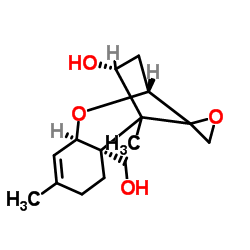Mass spectrometry-based strategy for direct detection and quantification of some mycotoxins produced by Stachybotrys and Aspergillus spp. in indoor environments.
Erica Bloom, Karol Bal, Eva Nyman, Aime Must, Lennart Larsson
文献索引:Appl. Environ. Microbiol. 73(13) , 4211-7, (2007)
全文:HTML全文
摘要
Dampness in buildings has been linked to adverse health effects, but the specific causative agents are unknown. Mycotoxins are secondary metabolites produced by molds and toxic to higher vertebrates. In this study, mass spectrometry was used to demonstrate the presence of mycotoxins predominantly produced by Aspergillus spp. and Stachybotrys spp. in buildings with either ongoing dampness or a history of water damage. Verrucarol and trichodermol, hydrolysis products of macrocyclic trichothecenes (including satratoxins), and trichodermin, predominately produced by Stachybotrys chartarum, were analyzed by gas chromatography-tandem mass spectrometry, whereas sterigmatocystin (mainly produced by Aspergillus versicolor), satratoxin G, and satratoxin H were analyzed by high-performance liquid chromatography-tandem mass spectrometry. These mycotoxin analytes were demonstrated in 45 of 62 building material samples studied, in three of eight settled dust samples, and in five of eight cultures of airborne dust samples. This is the first report on the use of tandem mass spectrometry for demonstrating mycotoxins in dust settled on surfaces above floor level in damp buildings. The direct detection of the highly toxic sterigmatocystin and macrocyclic trichothecene mycotoxins in indoor environments is important due to their potential health impacts.
相关化合物
| 结构式 | 名称/CAS号 | 分子式 | 全部文献 |
|---|---|---|---|
 |
(4α,12ξ)-12,13-Epoxytrichothec-9-ene-4,15-diol
CAS:2198-92-7 |
C15H22O4 |
|
Mycotoxins in Plant-Based Dietary Supplements: Hidden Health...
2015-07-29 [J. Agric. Food Chem. 63 , 6633-43, (2015)] |
|
Determination of the Mycotoxin Content in Distiller's Dried ...
2015-11-04 [J. Agric. Food Chem. 63 , 9441-51, (2015)] |
|
Mycotoxins in crude building materials from water-damaged bu...
2000-05-01 [Appl. Environ. Microbiol. 66 , 1899-1904, (2000)] |
|
Pharmacokinetics of the trichothecene mycotoxin verrucarol i...
1990-06-01 [J. Pharm. Sci. 79 , 548-551, (1990)] |
|
[Fusarium toxins in feed. Detection and occurrence of tricho...
1985-01-01 [Tierarztl. Prax. Suppl. 1 , 8-19, (1985)] |